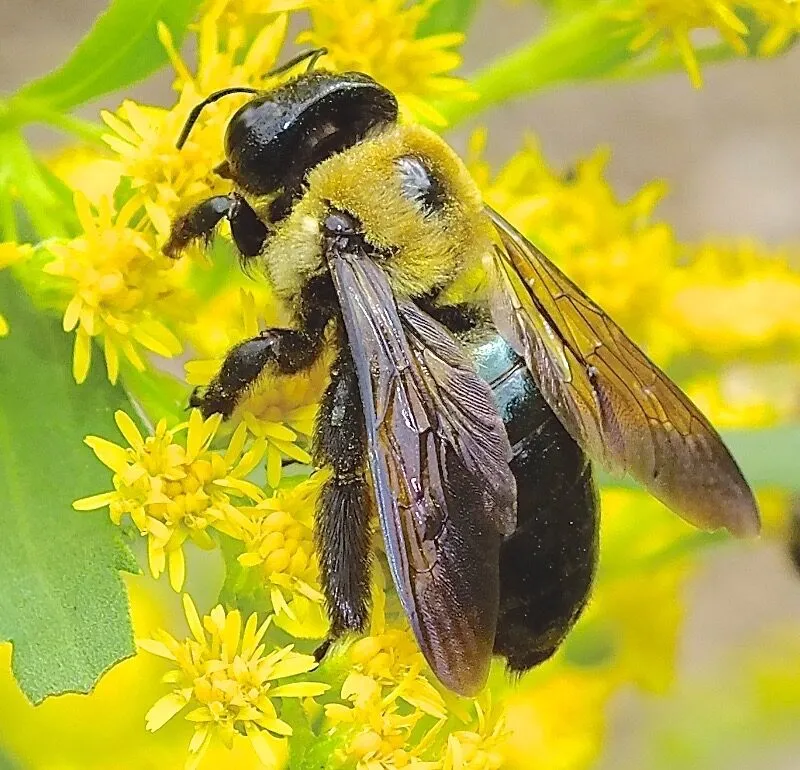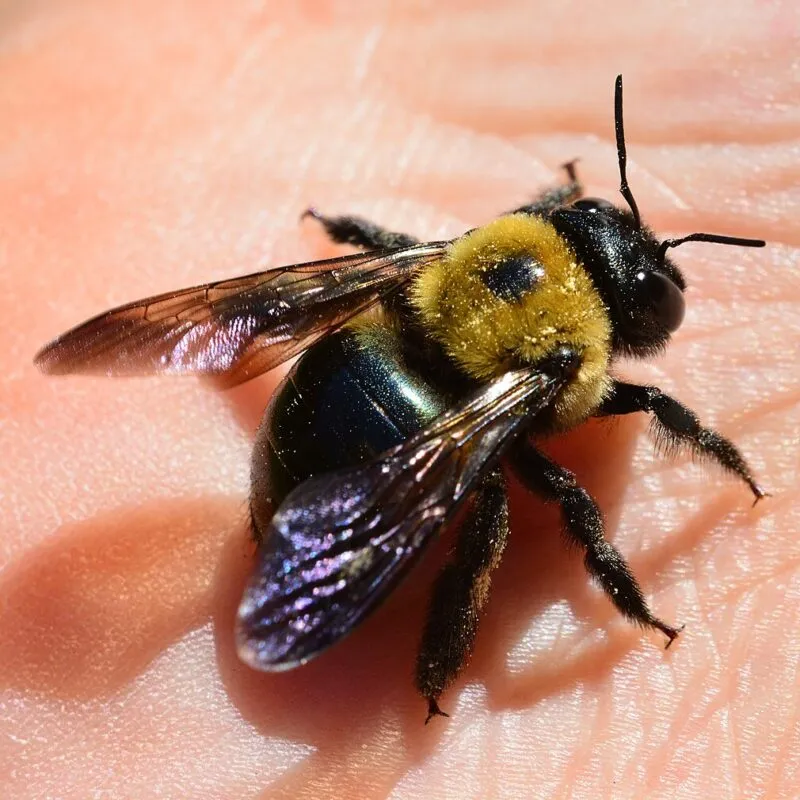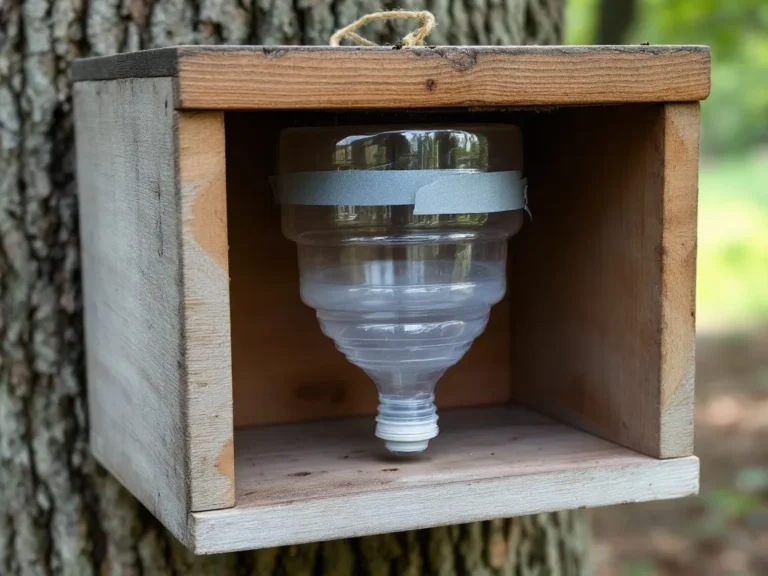Carpenter bees are fascinating creatures known for their solitary behavior and unique nesting habits. Unlike honeybees, carpenter bees don’t live in large colonies but prefer to carve out individual nests in wood. While they play a crucial role in pollination, their tendency to bore into wooden structures can make them a concern for homeowners.
Understanding the different types of carpenter bees is essential for proper identification and management. In this article, we’ll explore the various species of carpenter bees, their characteristics, and their behavior, helping you recognize these wood-boring bees and protect your property effectively.
1. The Large Carpenter Bees (Xylocopa spp.)
a. Overview: The large carpenter bees, belonging to the genus Xylocopa, are the most well-known and widely distributed type of carpenter bees. These bees are often mistaken for bumblebees due to their similar size and appearance, but they have distinct differences.
b. Characteristics:
- Size: Large carpenter bees are robust, with adults typically measuring between 0.75 to 1 inch in length.
- Appearance: They have a shiny, black abdomen with few or no hairs, which differentiates them from the hairy abdomens of bumblebees. Their thorax may be covered in yellow, orange, or white hairs, depending on the species.
- Behavior: These bees are solitary, meaning each female creates and maintains her own nest. They bore into wood to lay eggs and store food for their larvae.
c. Common Species:

- Xylocopa virginica: Also known as the Eastern carpenter bee, this species is common in the eastern United States and is one of the largest species.

- Xylocopa violacea: Known as the Violet carpenter bee, this species is found in Europe and Asia and is recognized by its metallic blue-black color.
2. The Small Carpenter Bees (Ceratina spp.)
a. Overview: The small carpenter bees, belonging to the genus Ceratina, are much smaller than their Xylocopa counterparts. Despite their size, these bees are also proficient wood-borers, often targeting smaller, softer wood or plant stems.
b. Characteristics:
- Size: Small carpenter bees are petite, with adults measuring around 0.15 to 0.3 inches in length.
- Appearance: They have a slender, black or metallic blue-green body with less hair than large carpenter bees. Their small size and shiny appearance make them look more like flies than bees.
- Behavior: Like their larger relatives, small carpenter bees are solitary. They tend to bore into twigs, plant stems, and soft wood to create their nests.
c. Common Species:

- Ceratina calcarata: Found in North America, this species is small, black, and often nests in pithy stems or soft wood.

- Ceratina smaragdula: Known for its bright green color, this species is found in parts of Asia and Australia.
Geographic Variations: Carpenter Bees Around the World
Carpenter bees are found in various regions around the world, and their appearance and behavior can vary depending on their environment. Here’s a look at some regional variations:
a. North American Carpenter Bees: In North America, the most commonly encountered carpenter bee is Xylocopa virginica. This species is widespread across the eastern U.S. and southern Canada. They are known for their habit of boring into softwoods like pine, cedar, and redwood.
b. European Carpenter Bees: In Europe, the Xylocopa violacea, or Violet carpenter bee, is a prominent species. Known for its striking color, this bee is often seen in gardens and rural areas. It prefers nesting in old wood or dead tree branches.
c. Asian Carpenter Bees: Asia is home to several species of carpenter bees, including Xylocopa tranquebarica and Xylocopa aerata. These species vary in color, from metallic blue to deep black, and are commonly found in tropical and subtropical regions.
The Role of Carpenter Bees in the Ecosystem
Carpenter bees, despite their reputation as pests, play a crucial role in the ecosystem. Here’s how they contribute:
a. Pollination: Carpenter bees are excellent pollinators. As they forage for nectar, they transfer pollen from flower to flower, aiding in the reproduction of plants. Their large size allows them to pollinate flowers that other bees might find difficult to access.
b. Biodiversity Support: By nesting in dead wood, carpenter bees help break down organic material, contributing to the natural decomposition process. This, in turn, supports other species that rely on decomposing wood for food and shelter.
c. Indicator Species: Carpenter bees can serve as indicator species, meaning their presence can provide insight into the health of an ecosystem. A thriving carpenter bee population often indicates a healthy environment with plenty of flowering plants and natural nesting sites.
Identifying Carpenter Bees: Key Features to Look For
When trying to identify carpenter bees, here are some key features to consider:
- Size and Shape: Large carpenter bees are robust and similar in size to bumblebees, while small carpenter bees are slender and petite.
- Abdomen: Carpenter bees typically have a shiny, hairless abdomen, unlike bumblebees, which have a hairy abdomen.
- Nesting Behavior: Look for round holes in wood, about 0.5 inches in diameter, which indicate the presence of carpenter bees.
- Flight Pattern: Carpenter bees are often seen hovering around wooden structures, especially in spring when they are most active.
How to Manage Carpenter Bees on Your Property
If you’re dealing with carpenter bees on your property, understanding their behavior and knowing the different types can help you manage them effectively:
a. Preventive Measures:
- Seal Wood: Use caulk or wood filler to seal existing holes and prevent bees from returning.
- Treat Wood: Apply paint, stain, or wood preservative to make surfaces less attractive to bees.
- Install Traps: Use carpenter bee traps to capture bees before they establish new nests.
b. Professional Help: If the infestation is severe, consider hiring a professional pest control service. They can apply targeted treatments and offer long-term solutions.
Final Toughts
Carpenter bees are a diverse group with important ecological roles, but they can also pose a challenge for homeowners. By understanding the different types of carpenter bees and their behavior, you can better appreciate their contribution to the environment while taking steps to protect your property.
Whether you’re dealing with large carpenter bees boring into your deck or small ones nesting in your garden, knowledge is key to effective management. Embrace the beauty of these pollinators while ensuring your home remains safe and damage-free.
Resources
For those interested in learning more about carpenter bees and how to manage them, here are some helpful resources:
- University of Kentucky Entomology: Carpenter Bees
- A detailed guide on identifying and managing carpenter bees, including tips on prevention and control.
- Read more here.
- National Pest Management Association (NPMA): Carpenter Bees
- Information on carpenter bee behavior, the damage they can cause, and how to protect your home.
- Visit NPMA.
- The Xerces Society: Pollinator Conservation
- Learn about the importance of carpenter bees in pollination and how to support their populations while protecting your home.
- Explore their resources.
- Homeowner’s Guide to Carpenter Bees
- A comprehensive PDF guide covering the lifecycle, identification, and prevention of carpenter bee infestations.
- Download the guide.





